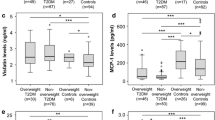Abstract
Objective: Hypertrophic obesity correlates with metabolic complications of obesity. We evaluated adipocyte volume and its relationship with tumor necrosis factor α (TNF-α), interleukin-6 (IL-6), adiponectin and high sensitivity C-reactive protein (hs-CRP) levels. Subjects and methods: Patients were divided into 4 groups; lean healthy controls [body mass index (BMI): 24.2±1.4 kg/m2], non-diabetic obese patients (30.2±2.9), obese (30.1 ±3.2) and non-obese (22.2±1.5) Type 2 diabetic patients. TNF-α, hs-CRP, adiponectin and IL-6 levels were measured preoperatively and sc fat specimens were obtained during operation. Semi-thin sections were stained with toluidine-blue and evaluated by light microscopy. Fat volumes were calculated by Goldrick’s formulation. Results: Mean adipocyte volumes were higher in obese diabetic patients than in other groups (p<0.0001). Mean TNF-α, hs-CRP and IL-6 levels were higher in obese diabetic patients than in control subjects, obese non-diabetic and non-obese diabetic patients (p<0.0001, p<0.02 and p<0.01. respectively). Mean TNF-α levels of non-diabetic obese patients were higher than the control group (p<0.05). Mean IL-6 levels of diabetic and non-diabetic obese patients were higher than control subjects (p<0.02 and p<0.0001, respectively). Mean adiponectin levels of control subjects were higher than non-diabetic obese, non-obese diabetic and obese-diabetic subjects (p<0.0001). Mean adiponectin levels of obese diabetic patients were lower than non-diabetic obese subjects (p<0.008). Mean hs-CRP levels were higher in diabetic patients whether they were obese or not. There was a positive correlation between adipocyte size and TNF-α (p<0.01), IL-6 (p<0.03) and hs-CRP levels (p<0.004), and negative correlation between adipocyte size, adiponectin levels (p<0.0001). Conclusions: TNF-α, IL-6 and hs-CRP levels were positively, adiponectin negatively correlated with adipocyte size. Therefore, adiposity may be an inflammatory condition.
Similar content being viewed by others
References
Salans LB, Cushman SW, Weismann RE. Studies of human adipose tissue. Adipose cell size and number in nonobese and obese patients. J Clin Invest 1973, 52: 929–41.
Bray GA, Ryan DH. Clinical evaluation of the overweight patient. Endocrine 2000, 13: 167–86.
Aronne LJ. Classification of obesity and assessment of obesity-related health risks. Obes Res 2002, 10 (Suppl 2): 105S–15S.
Cottam DR, Mattar SG, Barinas-Mitchell E, et al. The chronic inflammatory hypothesis for the morbidity associated with morbid obesity: implications and effects of weight loss. Obes Surg 2004, 14: 589–600.
Bernshtein LM. Hormones of adipose tissue (adipocytokines): ontogenetic and oncologic aspects. Adv Gerontol 2005, 16: 51–64.
Bastard JP, Jardel C, Bruckert E, et al. Elevated levels of interleukin 6 are reduced in serum and subcutaneous adipose tissue of obese women after weight loss. J Clin Endocrinol Metab 2000, 85: 3338–42.
Bruun JM, Lihn AS, Pedersen SB, et al. Regulation of adiponectin by adipose tissue-derived cytokines: in vivo and in vitro investigations in humans. Am J Physiol Endocrinol Metab 2003, 285: E527–33.
Yudkin JS. Adipose tissue, insulin action and vascular disease: inflammatory signals. Int J Obes Relat Metab Disord 2003, 27 (Suppl 3): S25–8.
Hotamisligil GS, Murray DL, Choy LN, Spiegelman BM. Tumor necrosis factor alpha inhibits signaling from the insulin receptor. Proc Natl Acad Sci USA 1994, 91: 4854–8.
Ofei F, Hurel S, Newkirk J, Sopwith M, Taylor R. Effects of an engineered human anti-TNF-alpha antibody (CDP571) on insulin sensitivity and glycemic control in patients with NIDDM. Diabetes 1996, 45: 881–5.
Matthews DR, Hosker JP, Rudenski AS, Naylor BA, Treacher DF, Turner RC. Homeostasis model assessment: insulin resistance and β-cell function from fasting plasma glucose and insulin concentrations in man. Diabetologia 1985, 28: 412–9
Goldrick RB. Morphological changes in the adipocyte during fat deposition and mobilization. Am J Physiol 1967, 212: 777–82.
European Concerted Action on Thrombosis and Disabilities Angina Pectoris Study Group, Haverkate F, Thompson SG, Pyke SD, Gallimore JR, Pepys MB. Production of C-reactive protein and risk of coronary events in stable and unstable angina. Lancet 1997, 349, 462–6.
Ridker PM, Glynn RJ, Hennekens CH. C-reactive protein adds to the predictive value of total and HDL cholesterol in determining risk of first myocardial infarction. Circulation 1998, 97: 2007–11.
Ridker PM, Hennekens CH, Buring JE, Rifai N. C-reactive protein and other markers of inflammation in the prediction of cardiovascular disease in women. N Engl J Med 2000, 342: 836–43.
Danesh J, Whincup P, Walker M, et al. Low grade inflammation and coronary heart disease: prospective study and updated meta-analyses. BMJ 2000, 321: 199–204.
Bahceci M, Tuzcu A, Ogun C, Canoruc N, Iltimur K, Aslan C. Is serum C-reactive protein concentration correlated with HbA1c and insulin resistance in Type 2 diabetic men with or without coronary heart disease? J Endocrinol Invest 2005, 28: 145–50.
Curat CA, Miranville A, Sengenes C, et al. From blood monocytes to adipose tissue-resident macrophages: induction of diapedesis by human mature adipocytes, Diabetes 2004, 53: 1285–92.
Weisberg SP, McCann D, Desai M, Rosenbaum M, Leibel RL, Ferrante AW. Obesity is associated with macrophage accumulation in adipose tissue, J Clin Invest 112, 2003: 1796–808.
Xu H, Barnes GT, Yang Q, et al. Chronic inflammation in fat plays a crucial role in the development of obesity-related insulin resistance, J Clin Invest 112, 2003: 1821–30.
Kalantar-Zadeh K, Block G, Horwich T, Fonarow GC. Reverse epidemiology of conventional cardiovascular risk factors in patients with chronic heart failure. J Am Coll Cardiol 2004, 43: 1439–44.
Author information
Authors and Affiliations
Corresponding author
Rights and permissions
About this article
Cite this article
Bahceci, M., Gokalp, D., Bahceci, S. et al. The correlation between adiposity and adiponectin, tumor necrosis factor α, interleukin-6 and high sensitivity C-reactive protein levels. Is adipocyte size associated with inflammation in adults?. J Endocrinol Invest 30, 210–214 (2007). https://doi.org/10.1007/BF03347427
Accepted:
Published:
Issue Date:
DOI: https://doi.org/10.1007/BF03347427




